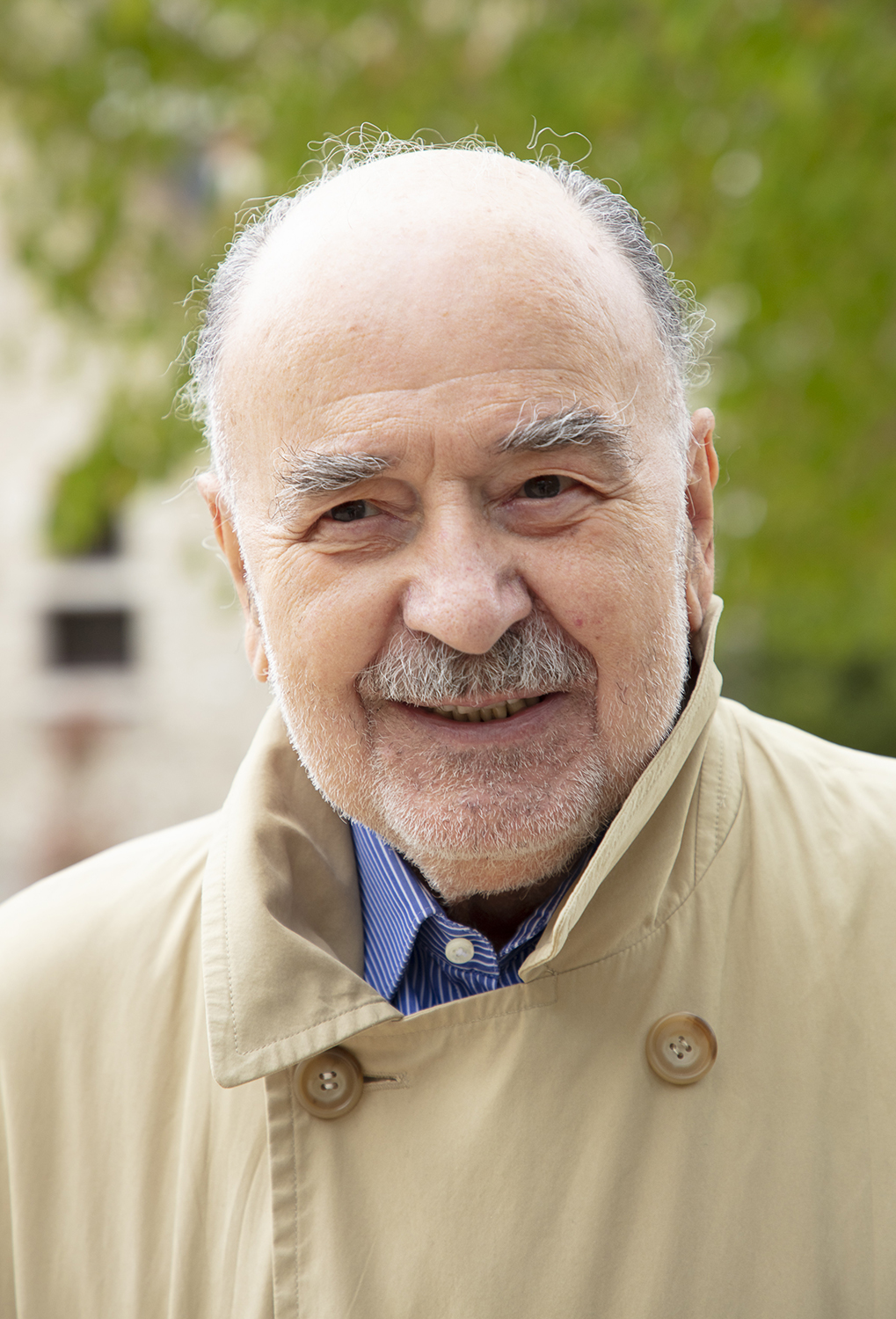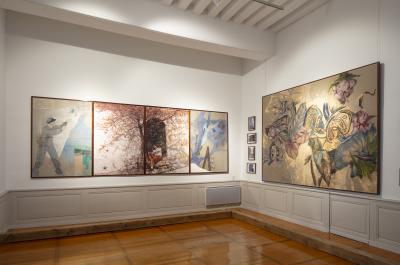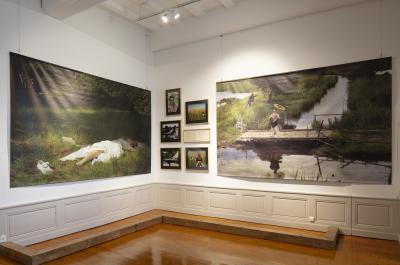A. Jean Le Gac
"En plein air"

Jean Le Gac’s unique career embodies the story of a painter’s relationship with nature and the world. He poses as a landscape painter in his own works. According to him, this mythological representation of the artist is “a metaphor for painting”.
The constant and concurrent use of text and image allow him to draw us into his poetic imagination, transporting us on his inner voyages full of herbaria, plants, pastels, and photographs, the traces of real and imaginary wanderings.
Jean Le Gac’s work is the result of a poetic combination of three means of expression: photography, painting, and writing.
The works exhibited in Chaumont-sur-Loire immerse us in the diversity of the artist’s views on the world, his walks, his meditations, his daydreams, his comings-and-goings between the visible and non-visible, between real and imaginary worlds.
Throughout years of this process, the artist has affirmed his particular vision of the world and of the nature and landscapes that surround him. The exhibition at Chaumont-sur-Loire groups together an unprecedented number of paintings, photographs and texts allowing us access to the unique universe of the artist’s memory, in deep resonance with our own.
“(…) When we open our eyes, we see only a part of the landscape; when we close them, we can recreate it in 360° in no more than the time we spent actually looking at it. Beyond this limit, beyond what the eye can see, the totality of the world is never comprehended and never can be understood without withdrawing from it. “I do not know the mysticism of pure painting but rather that of the enunciation of things…”(…) This is the mad venture that the artist embarks on, disguised as the Painter: to simultaneously draw both the visible and the invisible that surround him into his work, to enunciate its transformation by means of strategically playing one shape that chooses to be many, to stir up the word and the image that split off from each other within the same semantic field, to allow the Painter to show himself within the same physical space at the cost of the Artist leaving, to open up the work’s present time to the freeing of a past that continually resurfaces, breaching the boundaries of possibility by including within it an outside which lets the spectator in on the secret, if, of course, he is willing to make the effort and so doing place himself in violation of the laws.” Courtesy of Evelyne Artaud, with a quote from Jean Le Gac in italics
This is how Jean Le Gac has become an artist with multiple identities, “a painter-photograph, a contemporary painter, a non-existent painter, the painter-performer, the virtuoso painter, the painter wandering on the edge of art, the phantom painter, the painter who collects books, the chameleon painter, the fake landscape artist, the landscape artist, the painter of stories of all types, the painter who introduces fiction into plastic arts, not some phoney genius, the distracted painter, the nocturnal painter, the fictional painter.” Robert Bonaccorsi
BIOGRAPHICAL NOTES

Born in Tamaris, Alès in 1936, Jean Le Gac displayed an outstanding gift for drawing and painting early in life. He earned his degree in drawing education and plastic arts and began teaching in 1958. Towards the end of the 1960s, he began seeking out models within the humanities, literature, and photo-novels, and gathered inspiration from his personal experiences. Upon discovering New Criticism, he adopted the notion that creation cannot exist without discourse and quickly arrived at the conclusion that the painting cannot do without its own commentary. In Cahiers (1968-71), he presented 26 school notebooks open to display a handwritten text on one page and an amateur photograph on the other.
Swiss coordinator Harald Szeeman presented the artist’s work as part of the “Individual Mythologies” section at the Documenta V exhibition in Kassel (1972). The figure of the painter began to appear more and more often in the works that followed, featuring texts and images displayed on walls (Le peintre, 1973).
In 1977, the Hamburg Kunstverein organised a retrospective exhibition entitled The Painter, which travelled through West Germany to Munich and Aix-la-Chapelle. The following year, the Musée National d’Art Moderne displayed an updated version of the exhibition with new works specially designed for the Centre Pompidou, entitled Le Peintre, exposition romancée.
In 1987, Le Gac’s work Histoire was commissioned by the FRAC Centre to tell the story of the dynasty of kings who reigned over France with their seat in the Centre-Val de Loire region. Blending photo, text, and other mixed techniques representative of the artists’ favourite media, this triptych in celebration of the events of a great national history remains true to Jean Le Gac’s dearest concern: the close entanglement of his work with his own personal history. An inscription in the upper pastel reads: “The painter discovers his own history in his images, which in his youth had awakened him to Art.”
Le Gac also creates videos, such as his 25e Message (1995) or his In Memoriam (1999), in which he imagines his own wake.
In 2002 and 2003, he created an art walk for the city of Vence between two exhibitions, one at Château Villeneuve, where he took over every single room, and the other in the Beaubourg gallery at Château Notre-Dame-des-Fleurs. In the first exhibition, his works were displayed side by side with carefully chosen pieces by other artists. By sometimes using other objects in the room or even the colour of the walls, he created an environment in which bonds were formed, interactions or links serving as narration. The gallery exhibit, on the other hand, recreated an Orientalist atmosphere to surround the artist’s odalisque-themed paintings.
In 2010, the Jean Le Gac exhibition revealing paintings from the collections of contemporary art museum, àcentmètresducentredumonde, in Perpignan was shown at the Maison René Char in L’Isle-sur-la-Sorgue and at the Pavillon Carré de Baudoin in Paris.
Alongside his solo exhibitions, the artist participated yearly in group exhibitions held at iconic contemporary art locations such as the Ivry Centre d’Art Contemporain, or Credac (Tout le monde, 2015), the Saint-Etienne Musée d’Art Moderne et Contemporain (Considérer le monde: Narrative Art, 2017), the Fondation Maeght in St. Paul de Vence, and the Institut du Monde Arabe (2018).
Le Gac’s artistic stance and style, positioned somewhere between image and narrative, create a disturbance among the established categories. He opposes the so-called truths of Art and History with the simulacrum of the personal adventure, both lived and dreamed. The artist’s work is often on show, mostly in France but also in Germany and Japan (2011–2017).


